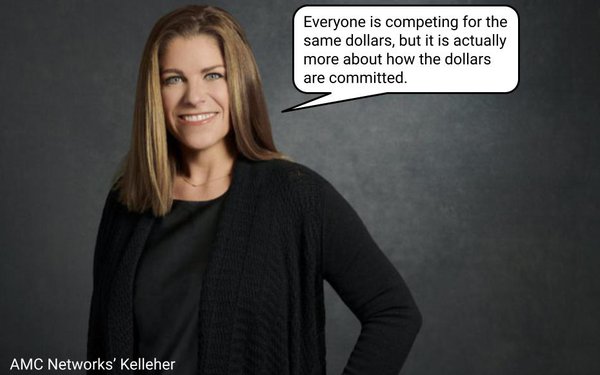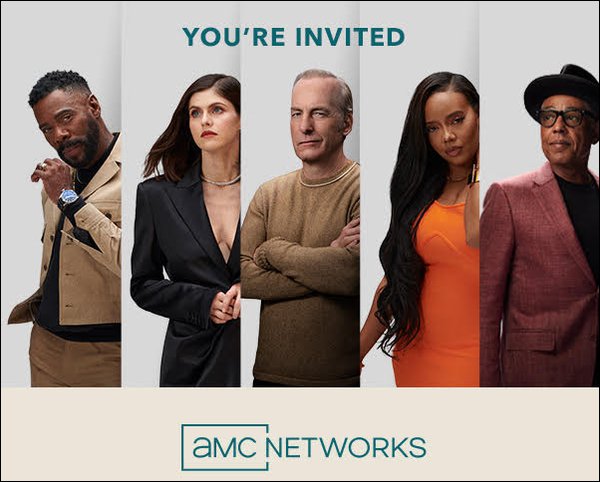On The Eve Of Her Upfront, AMCN's Kelleher On Upfronts Vs. Newfronts
- by Adam Buckman , April 18, 2023

What’s the difference between a newfront and an upfront? According to Kim Kelleher, Chief Commercial Officer of AMC Networks, it comes down to the way ad deals are booked.
“Everyone is competing for the same dollars,” she explained during a pre-upfront interview last week at AMCN’s Manhattan offices. “But it is actually more about how the dollars are committed.”
AMCN’s upfront event, which takes place this evening at Jazz at Lincoln Center, will include wining and dining with network stars like Bob Odenkirk and Giancarlo Esposito.
The newfronts are mainly a series of presentations concentrated during a four-day event hosted by the Interactive Advertising Bureau (IAB), May 1-4.
Some 30 entities are on the schedule to present at the 2023 IAB NewFronts, ranging from short-form video giants such as YouTube and TikTok, to digital streamers of long-form scripted fare such as Amazon and NBCU’s Peacock, both of which offer ad-supported tiers.
advertisement
advertisement
“[With entities such as YouTube and TikTok], you have a user-generated content base,” said Kelleher.
They occupy an entirely different realm, she said. “I would be hard-pressed to believe that you can sell a purely brand-safe campaign on TikTok.”
“[But] we make shows like ‘Mad Men,’ ‘Breaking Bad’ and ‘Better Call Saul.’ The lead cycles and the production cycles on those shows are long. [All of the major television content streamers] have big shows, big productions and spend billions of dollars a year entertaining people,” she noted, adding: “That is not user-generated. [When we book business] we need to know the upfront commitment is a guaranteed commitment that holds outside of options -- [that] it’s not cancellable.”
Kelleher characterizes the newfronts more as “endeavors,” which she described as “a pledge and a communication that a certain amount of money is going to be spent.”
Another big difference, she said, is that unlike upfront network advertising commitments, digital dollars are cancellable within 14 days, because those are the IAB’s rules.
“In the upfronts, the closest you can get to cancellable are what are called monthly rolling options, but most are quarterly. And it’s only a percentage of the dollars. There truly is a difference.”
Traditionally, full year-network upfront advertising buys are 100% firm for the fourth quarter, 25% cancellable for the first quarter, and 50% cancellable for the second and third quarters of the broadcast year.
Beyond that, the terms upfront and newfront may just be in the eye of the presenter.
While Peacock and Amazon Prime Video are joining the “newfront” crowd this year, streaming giant Netflix will stage an “upfront” presentation on Wednesday of “Upfront Week” (May 17).
This spring marks the very first upfront sales season for Netflix, which launched its ad-supported tier last November.
Although it is Netflix’s first time around in the ad-supported sphere, it will not technically be alone in the digital streaming space during Upfront Week.
Disney+’s ad-supported tier will be a part of the presentation mix at the Disney Upfront on May 16, as will Disney-owned Hulu.
Also, on May 17, another major, Warner Bros. Discovery, will stage an upfront presentation in which the ad-supported tiers of HBO Max and Discovery+ will play a large part.
But for AMC’s Kelleher, whether or not Netflix will truly be regarded as an upfront entity by the ad buying community remains an open question.
She said she is waiting to see “if buyers are going to allow them to buy as ‘upfront’,” or regard their expenditures with Netflix as “digital dollars” cancellable within 14 days.
For its part, Netflix evidently sees itself as a full participant in the upfront marketplace, where it will be competing for the same dollars as everyone else, especially since every legacy TV company today also has digital inventory to sell.
“The nice thing about being a pure-play streamer is that I’m not going to show up [at the upfront] with some convoluted math that tries to put all sorts of different currencies together,” said Netflix Vice President of Global Advertising Sales Peter Naylor in an interview earlier this month with Ad Age.
“Some of the bigger, traditional companies are putting streaming impressions next to broadcast impressions next to digital display impressions, combining them with audience deficiency units,” he said.
“I’ve got the luxury of selling :15s and :30s in a streaming environment, in a very light ad load. I don’t have legacy concerns, so we can start this conversation with a clean slate. My goal is to make it as easy to buy and easy to sell Netflix as possible. I think that gives me an advantage.”



